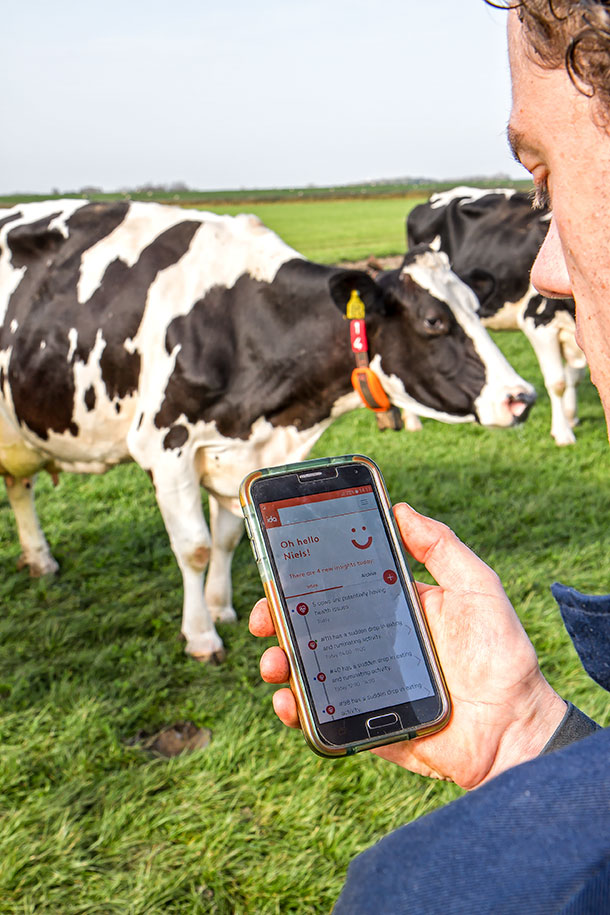Editor’s note: The CEO Corner contains editors’ compilations of business insights and analysis of current news, which they have tailored for the dairy industry. This column inspires million-dollar dairy operations to think like CEOs in other industries do. What if you could ask your smartphone to tell you which of your cows were lame? Or which cows were most likely to get sick in the next day or two? Or whether a switch from feeding last year’s silage to this year’s crop has impacted milk production? If you think that’s beyond the capabilities of Siri or Alexa, a Dutch-based company wants you to meet Ida.
Ida, or Intelligent Dairy-farming Assistant for short, was developed by Connecterra. The start-up company is the first in the dairy industry to claim its neck tags for cows not only gather activity data but then use artificial intelligence to detect individual deviations in cow behaviors. The company was recently featured in a Financial Times article about data sensors for cows and a Bloomberg Businessweek article about artificial intelligence.
“Our algorithms learn the individual behavior of the cow,” says Connecterra’s CEO Yasir Khokhar. “From a single sensor, we are the only company that can detect seven different cow behaviors.”
The cow behaviors it currently tracks, and learns from, are eating, ruminating, walking, lying, standing, mating and drinking. Heat stress detections were launched this summer and detection for calving and calving distress are coming soon, Khokhar says. The company is careful to distinguish what it does from other companies that gather data using neck tags. Khokhar describes Ida as a “baby brain” that lives in the cloud and is constantly learning. It’s machine-learning for the dairy industry.

“One thing that differentiates our artificial intelligence from statistical analysis is that our algorithms actually learn,” Khokhar says. “As the algorithm learns, it is getting better at what it does. The interface with Ida has buttons where a farmer can give feedback, say, ‘Nope, you’re wrong’ or ‘Yes, you’re right on this one.’ The consequences of this is that Ida is currently learning from some of the best farms in the world.”
More than 2,000 cows on a dozen different farms in Europe, Mexico, Canada, the Netherlands and the U.S. currently have the company’s neck tags and Ida-enabled interfaces. Three large-herd farms in the U.S. already have the technology on some of their cows.
Dairy farmers who want to put Ida to work on their farm lease the company’s data-logging neck collars. The company installs on-site computers for aggregating data. But the real computing power happens in the cloud, where the on-farm data is transferred and analyzed. The standard cost of the system is $8.75 per cow per month. Contracts for longer guaranteed use may have lower per-month pricing. As the company owns all of the on-farm equipment and leases it to the dairy owner, including the collars, any necessary repairs or upgrades are taken care of by the company without additional cost to the farmer.
The company claims Ida replaces time farmers would have spent in front of dashboards looking at graphs of data with actionable intelligence.
“What we see in the future is that we’ll be about to recommend actions you can take to solve problems,” Khokhar says.
For example, Khokhar says Ida might one day be able to suggest the steps that 70 percent of other farmers have used with success to correct X-kind of issue on farms.
The system can currently identify the beginning of the estrus cycle, suggest the optimal window for breeding, identify lame cows, predict the onset of an illness such as mastitis up to two days prior to clinical signs and gauge individual cow efficiency at milk production, when integrated with milk production data from a farm management software system, such as DairyComp305.
“The more cows that Ida sees within a certain type of dairying system, the better its accuracy gets over time,” Khokhar says. “That is also true for individual farms. We start from a baseline accuracy of 90 percent, and Ida learns the behaviors on every farm, and its insight becomes better and better.”
Down the road, Connecterra hopes to not just tell farmers what happened to a cow and suggest what he or she needs to do about it, but also confirm for the farmer when the problem went away.
Imagine the day when Ida can answer, “Yes, your new-crop silage increased average milk production by 2 pounds.” ![]()

-
Walt Cooley
- Editor-in-chief
- Progressive Dairyman
- Email Walt Cooley
PHOTOS: Photos courtesy of Connecterra.




